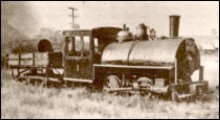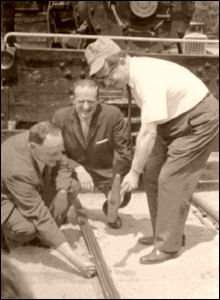
The History of the Real Pine Creek Railroad A detailed account of the Pine Creek Railroad's early years is difficult, as the period between 1950 (just prior to its founding) and 1965 (when it completed the move to Allaire State Park) is rife with gaps, conflicting information, and some tall tales. In particular, the histories of their first locomotives are quite muddled, and some details have intertwined in various accounts. Nevertheless, it's possible to piece together a fairly complete picture if you cast your information-gathering nets far and wide.
Together with Pierre "Pete" Rasmussen (an agent for the Central Railroad of New Jersey), Wright & Wulfson founded the Pine Creek Railroad Museum in 1952. They purchased a 2.5-acre plot of commercial real estate on Route 9 in Marlboro Township, New Jersey, a few miles north of Freehold, and set about building a little narrow-gauge railroad using rail rescued from abandoned sand pits. After laying some track and constructing a small engine house, they began attracting other railroad enthusiasts willing to volunteer their time, and eventually they cobbled together a passenger coach and ran the railroad as an amusement attraction. In 1956 Wright & Wulfson were then contracted to create a similar amusement ride at Cowboy City on Route 33 in Howell, New Jersey, and they set up a separate company called the Cranberry Creek Railroad, Inc., to build and operate the Copper Creek Railroad, comprising a 1,700-foot loop of track. No. 1 was shipped to the Copper Creek Railroad, but failed her annual state boiler exam, so they purchased another locomotive from Raritan River Sand—this time a Porter 0-4-0T saddle tanker—as a replacement. Unfortunately, Cowboy City started having difficulty paying their creditors, and when they closed, all of the rolling stock was returned to the Pine Creek Railroad Museum. By then, Pine Creek had leased Ely-Thomas Shay No. 6 from owner Edgar Mead. The volunteers had also formed the New Jersey Museum of Transportation, Inc., a new not-for-profit organization. Meanwhile, the Cranberry Creek Railroad Company had taken ownership of the standard gauge Middletown and New Jersey Railroad in Middletown, New York. And so the founders of Pine Creek and the volunteers who helped run it were destined to part ways. Pine Creek No. 1 was sold to Disneyland in California, whereas Copper Creek No. 3 and the two homemade coaches became the property of the Busch Woodlands Museum in Cooperstown, New York. Wulfson and Rasmussen then donated all of the remaining rolling stock and other assets to the New Jersey Museum of Transportation. In 1962 the museum's plans to relocate had become critical when, owing to a land reassessment, they were hit with a 300% property tax hike, which threatened to consume upwards of 70% of the museum's annual revenue. Unsuccessful in their bid to appeal their case with Marlboro Township, the museum was forced to move, and by winter had found their new home: Allaire State Park in Wall Township, Monmouth County. A charter was drawn up in December 1962 that formalized the creation of the not-for-profit Pine Creek Railroad Division of the New Jersey Museum of Transportation, Inc. The scope of the charter was deliberately broad so that they could incorporate other forms of transportation into the museum in the future, if they so chose. Their ambitious plans for the railroad itself included a two- to three-mile dogbone that was to feature a 30-foot high, 100-foot long trestle across a gully.
By 1967 the Pine Creek Railroad had come a long way: the station was refurbished, a new enginehouse was built, a Raritan River caboose was converted into living quarters for the resident machinist, the Railroadiana shop opened, a small diesel was acquired, and the Ely-Thomas Shay was running the loop, as reported by the NJMT Newsletter editor at the time, Theodore F. Gleichmann. Thanks to the efforts of many volunteers, the railroad has been in continuous operation ever since, and the museum has featured an ever-changing roster. This brief history was complied from many sources, beginning with the museum's own partial account from their official website. Researching the locomotives provided additional bits of information on the museum's somewhat enigmatic history. Locomotive histories were obtained from: Donald Nute, a researcher of steam locomotives; Steve DeGaetano, a Disney historian with a focus on their railroad; Keith Taylor from the Wiscasset, Waterville & Farmington Discussion Forum; Bob Withers writing for Trains Magazine; and numerous other assorted sources scattered far and wide. I have now begun the process of interviewing the members of the museum, past and present, which will allow me to continue building this history. For a more detailed look at the museum's first location, please see this new page, which will be expanded over time.
The second image is from the collection of Thurlow C. Haunton, Jr., courtesy of Benjamin L. Bernhart; the remaining images were provided by the New Jersey Museum of Transportation.
|
Copyright © 2010 by David K. Smith. All Rights Reserved.


 Work on the
new roadbed
began in 1963, making use of rail provided by Trooper Alden T. Cottrell, Chief of the Bureau of Forests and Parks, who obtained it from
an unused siding that ran to the county jail. While a search was reportedly undertaken to find an existing trestle that could be moved,
no further mention of the bridge can be found, and when the golden spike was driven on 20 June 1964 (with New Jersey Governor Richard
Hughes performing the honors, right), the loop of track had shrunk to just a little over half a mile. At this point the process of moving
everything to the new site was yet to be completed; the original land had been sold on 14 October 1964, and all remaining railroad
artifacts had to be removed by mid-1965, which included the ex-Jersey Central passenger station from Freneau in Aberdeen Township, and
Work on the
new roadbed
began in 1963, making use of rail provided by Trooper Alden T. Cottrell, Chief of the Bureau of Forests and Parks, who obtained it from
an unused siding that ran to the county jail. While a search was reportedly undertaken to find an existing trestle that could be moved,
no further mention of the bridge can be found, and when the golden spike was driven on 20 June 1964 (with New Jersey Governor Richard
Hughes performing the honors, right), the loop of track had shrunk to just a little over half a mile. At this point the process of moving
everything to the new site was yet to be completed; the original land had been sold on 14 October 1964, and all remaining railroad
artifacts had to be removed by mid-1965, which included the ex-Jersey Central passenger station from Freneau in Aberdeen Township, and



